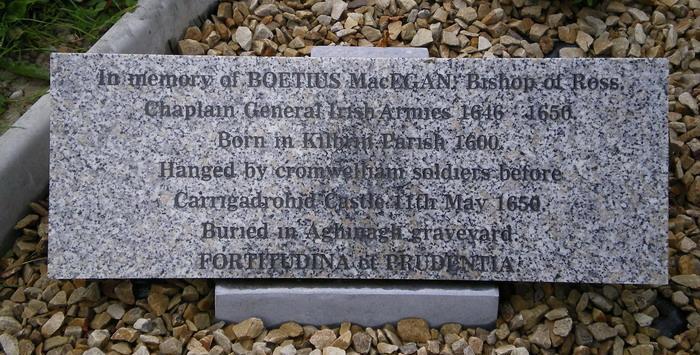

Boetius Mac Egan (Baothnalach Mac Aodhagáin) was, according to local tradition, born in Knockagolig, in the parish of Kilbrin and barony of Duhallow c.1600. In “Evidence From The Processus Datariae, January 30th, 1647", Thady Daly, a Franciscan, in endorsing the nomination of Mac Egan for the see of Ross, states: “Egan was born in lawful wedlock of noble parents in County Cork where his father owned a town called Ballygrady”. His family were hereditary brehons (legal experts) to the McDonough McCarthys, lords of Duhallow. Ballygraddy was probably a perquisite of the McEgans from the family profession.
Boetius probably attended school in the city of Cork c.1617. He later studied theology at Bordeaux ‘while still a secular’. He is probably to be identified with the Boetius Egan of the Irish college, Bordeaux, who was ordained 1627. After ordination he became a Franciscan and studied for several years at the university of Alcala de Henares. During the 1630’s he was regarded in Ireland as one of the leading preachers. Fr. Robert O’Connell, O.F.M.Cap., describes him as follows:-
"His face, his gestures, his walk, his words, his actions, truly revealed the apostolic man that he was. Nor can I forget how in that face and in those eyes of his shone the reflection of a religious, contrite, and humble soul, so that to this very day I can never think of him without picturing before my mind’s eye, to my own confusion, what sort a spiritual man should really be".
In August 1644, he became definitor or counsellor to the provincial. He attended to general chapter held in Toledo in Spain in June 1645. At this time he became definitor general to the northern branch of the Franciscan order.
In October 1645 the new nuncio, Rinuccini, landed at Kenmare. In Macroom he was joined by MacEgan who prevailed upon him to visit the McDonough McCarthys at their castle in Dromiscane. From that time he was a trusted member of Rinuccini’s inner circle.
In February 1646 McEgan was appointed chaplain-general to Owen Roe O’Neill’s army of Ulster. Before the battle of Benburb on 5 June 1646 the chaplain-general and assistant chaplains heard the confessions of officers and men, gave them Holy Communion, and led them in the litany of Our Lady and other prayers. McEgan invoked the apostolic blessing on the troops and gave them a plenary indulgence. Owen Roe had given careful thought to his choice of terrain. Skirmishing continued all day. Then towards sunset the general spoke some rousing words to his troops, invoked the Holy Trinity and gave them ‘Sancta Maria’ for their battle cry. He then ordered them to charge. The Anglo-Scot army was wiped out. Irish losses were negligible. On Sunday 14 June Boetius McEgan deposited over thirty captured battle flags in the cathedral in Limerick in the presence of the nuncio, several bishops and members of the supreme council of the Confederation of Kilkenny The Te Deum was then sung. Some of the flags were sent to Kilkenny and other towns in confederate hands. Some were sent to Pope Innocent X who put them on display in St.Peter’s.
On 25th March 1648, Robert Barry (up to then, vicar apostolic of Ross) was consecrated Bishop of Cork in Waterford and Boetius Mac Egan was consecrated Bishop of Ross. There is no reason to believe that he was ever able to set foot in his diocese. During his short episcopate he was deeply involved with the affairs of the confederation and was very highly regarded. In March 1649 the nuncio left Ireland for good. On 15 August Cromwell landed at Ringsend. Owen Roe O’Neill, the only man who might have been successful against him died at Cloughoughter castle. The Bishop of Ross played an important part in rallying the country against the enemy, to little avail. The Confederation fell to pieces. Kilkenny, the capital, surrendered on 28 March, 1650. On 10 May MacEgan was with an army commanded by Colonel David Roche near Macroom. On that day they were defeated by the local Cromwellian commander, Lord Broghill. The Bishop of Ross was captured and led by his captors before Carrigadrohid Castle, a strategic post still in Confederate hands. He was ordered, under threat of death, to order the garrison to surrender. He urged them to resist to the last. He was then hanged. Six young men, two O’Riordans from Currach an Iarla, two Dinans from Killinardrish, and two O’Learys from Cul Allta spirited the bishop’s body from the English camp along the southern bank of the Lee.
According to a strong tradition they were preceded by a ghostly light which led them across a ford in the river to Aghinagh graveyard where the Bishop was laid to rest. This story was first recorded by the historian John Lynch soon alter the death of Mac Egan. The enemy asserted that Mac Egan commanded the force with which he was captured. This, however, is highly unlikely. He did help to recruit for the force in Kerry but his role from that on was probably spiritual.
Many of his contemporaries regarded him as a martyr.
Author: